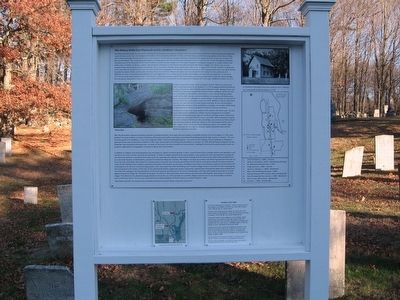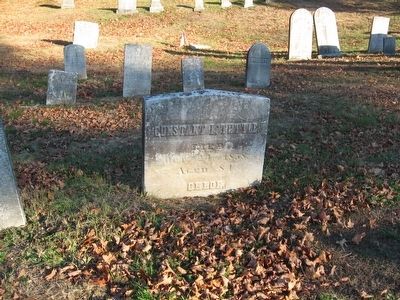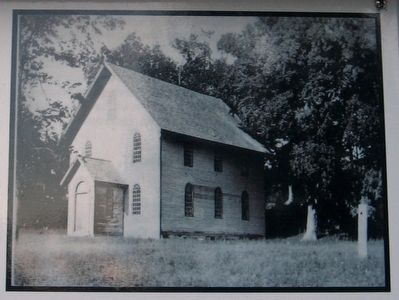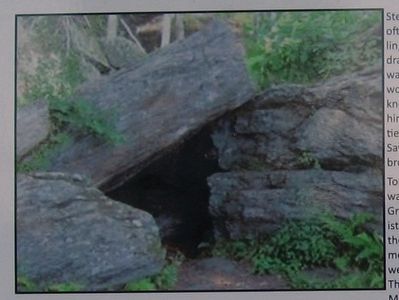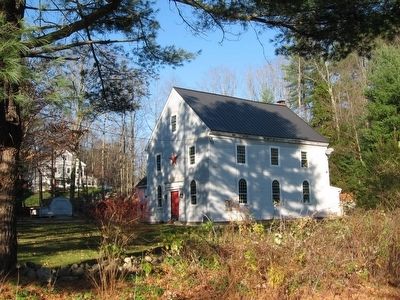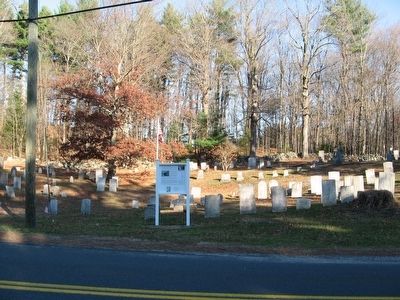Terryville in Plymouth in Litchfield County, Connecticut — The American Northeast (New England)
East Plymouth and St. Matthew’s Cemetery
Inscription.
The History of the East Plymouth and St. Matthew's Cemetery
East Plymouth (also known as East Church), located at the boundary convergence of Bristol, Plymouth and Harwinton, became a distinct community largely because of events occurring in the Chippeny Hill section of New Cambridge (Bristol). In 1747, an internal dispute within the congregation of the Church of England in New Cambridge divided the church into two factions. The first group, strongly Calvinistic in doctrine (New Lights) declared as their new minister, the Rev. Samuel Newell. The second group (Old Lights), rebelling against the more fundamental Calvinism, chose to remain in the Church of England. During the turbulent years of the Revolution, East Church residents maintained their allegiance to the King of England, an allegiance repugnant to Captain Wilson's Harwinton Sons of Liberty. As deacon, captain, and selectman and deputy in the General Assembly during the Revolution, Captain John Wilson was an unrestrained leader whose special targets were loyalist (Tory) churchmen. The Rev. James Nichols was such a man. In August 1773, the Rev. Nichols, a young man of 25, was called to the East Church area and soon infected his congregation of 45 families and 63 communicants with a strong loyalist spirit. Soon after, he was hounded by Captain Wilson and the Sons of Liberty who once found him hiding in the cellar near Cyrus Gaylord's home (about ¾ mile southwest of St. Matthews Church). They tarred and feathered him and dragged him into a nearby brook. Several assassination attempts were also reported. In January of 1777, he was tried by the Superior Court in Hartford for treasonable practices against the United States, but was acquitted. Not so lucky was Moses Dunbar, the only person executed as a traitor as a result of the trial by law in Connecticut. He was captured on Chippeny Hill and hung in Hartford on March 19, 1777.
Stephen Graves was another victim of Captain Wilson's raids as his house was often a rendezvous point for the loyalists. In 1778, he appeared before Daniel Catlin, Esq. and took the oath of fidelity and the freeman's oath. Stephen Graves was drafted in the American Continental Army but hired a substitute. While this man was in the field, he was drafted a second time. At the second drafting, Graves would neither fight nor pay a second substitute. His sympathy with Britain thus known, he came to the attention of Captain Wilson. A mob seized him and carried him to a fork in the roads about a mile north of St. Matthew's Church where they tied him to a tree and beat him with hickory branches. He was also arrested in Saybrook at the residence of his grandfather on charges of desertion. While being brought back to
his home he escaped to Tories Den and was not found.
Tories Den is a cave in the rocky section of the northern Old Marsh area. The Den was re-discovered in 1838 by X.A. Welton. He was the grandson of Stephen Graves who accidentally came upon the southern and larger section. Many loyalists' names are associated with this haven. Joel Tuttle, after having been hung by the neck on Federal Hill Green in New Cambridge, was cut down by fellow churchmen and took refuge at Tories Den. Others in his family frequented the cave as well – Simon Tuttle and his sons Daniel, Ebenezer and his son Constant Loyal. There were also the Carringtons, Lemuels, Captain Nathaniel Jones and Matthews and the Matthews and Jerome families.
After the Revolution, despite the obvious recession of political loyalism, there were still many people in sympathy with the Church of England. In 1790, upon petition from loyal residents of eastern Northbury (Plymouth) and southern Harwinton, the General Assembly granted the right to form a “society”. This was to be the parish of St. Matthew's, or as it was originally called, The Second Episcopal Society. As a result of this meeting, a church building, St. Matthew's Episcopal Church was constructed. Finished in 1794, it was consecrated by the Bishop Samuel Seabury on October 21, 1795. Bishop Seabury ordained the Rev. Alexander Viets Griswold at the same
time. As rector of the church, the Rev Griswold was instrumental in leading the community towards peaceful, post-war purposes. Agreeably, his congregation increased to about 220 communicants.
In addition to religious and social prosperity, the area began to support economic growth. In 1815, Luman Preston built a carding machine and operated a carding mill on the stream, which runs from the Old Marsh. In 1818, he added a gristmill at the same location. Cyrus Gaylord too built and operated a carding mill near his home and built a second structure close by for the spinning and weaving of wool and the dressing of cloth, the business affairs being handled by Sextus and Joseph Gaylord. Josiah Kimberly used part the Gaylord building for a tannery. The village at its peak was a busier manufacturing area than Terryville. Eli Terry, the early clockmaker who started his manufacturing in Terryville, was so impressed with East Church that he made plans to divert the Poland Brook by canal into the Old Marsh, but residents protested to the extent that he gave up such plans. A tradition states that Luman Preston would not sell the Marsh mill and property to Eli Terry for manufacturing purposes. One reason given was that the building up of a factory village would ruin the church. Such reasoning was the turning point in the history of the area. As the industrial Revolution progressed, greater employment opportunities attracted the labor force to Bristol and Terryville, thus leading to the eventual demise of the local industries and decrease in the church membership. East Plymouth today has returned to its quiet dignity of close-knit village life. The factories are gone, the church is de-consecrated; what is left are period houses reflecting the many facets of a once busy village. The settlement has attracted enough attention and concern (as a fine example of a primitive village) to be the fulcrum of several highly successful tours of historical homes. This area was nominated to the National Register of Historic Places as a Historic District in 1985.
Information provided are excerpts from the National Register of Historic Places nomination document.
Constant Loyal Tuttle was born in Bristol on January 28, 1775, when tensions ran high between Tories, who were loyal to the King of England, and the Rebels, who wanted independence.
Tories were forced to claim allegiance to their rebelling colonial governments if they wanted to keep their property. Many did, including Ebenezer Tuttle. However, Ebenezer's true
feelings were revealed when he named his son, “Constant Loyal”, to show the Rebels he wasn't intimidated by their scare tactics!
Constant Loyal Tuttle married Chloe Matthews and lived on Hill Street in the Chippens Hill section of Bristol. The house is still there. He built a tannery that made leather for harnesses and shoes. He was a member of the Free Masons and a Justice of the Peace. He died in 1858.
More information about East Plymouth, including a list of people buried in St Matthew's Cemetery, can be found at www.plymouthhistoricalsociety.org.
The Society thanks Gregg Rahuba, who mapped the cemetery and recorded the inscriptions of the gravestones for a Boy Scout Eagle Project.
Topics. This historical marker is listed in these topic lists: Cemeteries & Burial Sites • Colonial Era • Settlements & Settlers.
Location. 41° 41.918′ N, 72° 59.933′ W. Marker is in Plymouth, Connecticut, in Litchfield County. It is in Terryville. Marker is at the intersection of East Plymouth Road and Marsh Road, on the right when traveling north on East Plymouth Road. Touch for map. Marker is at or near this postal address: 160 East Plymouth Road, Terryville CT 06786, United States of America. Touch for directions.
Other nearby markers. At least 8 other markers are within 2 miles of this marker, measured as the crow flies. James Johnson House (about 700 feet away, measured in a direct line); Terryville Soldiers Memorial (approx. 1.2 miles away); 1835 Highway Marker (approx. 1.4 miles away); Dorence Atwater, Plymouth's Civil War Hero (approx. 1.4 miles away); Loyal Sons and Daughters (approx. 1½ miles away); Plymouth Veterans Monument (approx. 1½ miles away); Plymouth Vietnam Veterans Memorial (approx. 1½ miles away); Original Date Stone (approx. 1½ miles away). Touch for a list and map of all markers in Plymouth.
Regarding East Plymouth and St. Matthew’s Cemetery. St. Matthew's Church, dating from 1792, lies within the East Plymouth Historic District, which was listed on the National Register of Historic Places in 1985. Please note the former church is now a private residence.
Credits. This page was last revised on July 30, 2023. It was originally submitted on November 23, 2015, by Michael Herrick of Southbury, Connecticut. This page has been viewed 358 times since then and 34 times this year. Photos: 1, 2, 3, 4, 5, 6. submitted on November 23, 2015, by Michael Herrick of Southbury, Connecticut.
